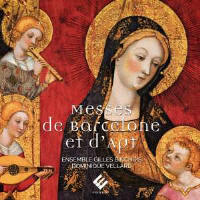Texte paru dans: / Appeared in:
Evidence Classics |
|
|
Reviewer: J.
F. Weber Among the polyphonic Masses that existed before Machaut composed the Messe de Nostre Dame, the Messe de Tournai (MS A 27) is the most well known and most recorded (summarized in Fanfare 34:6). The Messe de Barcelona is next, recorded by Eberhard Hofmann, Gregorio Paniagua, Mark Brown, McNeil Robinson, Pierre Hudrisier, and Emanuel Bonnardot (summarized in 19:6). It is a set of five Ordinary movements, but it is unlikely that they were composed as a unit, though all are for three voices except the four-voice Agnus Dei. Another anonymous Mass of the period is found at Toulouse (B.M. MS 94), recorded by McNeil Robinson and Hudrisier on the same discs as the Barcelona Mass. Music historians also write about a Sorbonne Mass, once thought to have originated in Besançon, that has four incomplete movements and no Credo, but it has never been recorded to my knowledge.
The most recent such issue was directed by Marcel Pérès (33:5). His disc included all four movements of the Toulouse Mass (Kyrie, Sanctus, Agnus Dei, as well as the Ite missa est), its third recording, filled out by the Gloria and Credo that are found in both Barcelona (MS 971, olim 946) and the Apt codex (MS 16bis). This latter source has 10 Kyries, nine Glorias, 10 Credos, four Sanctus, and one Agnus Dei, so a reference to “the Apt Mass” would be misleading. Pérès’s disc was filled out with three chant Propers.
The present disc presents two Masses, Barcelona and Apt. The latter codex is a collection of 49 pieces for two, three, or four voices (mostly three), and the numerous Ordinary movements are not grouped together as cycles. Oddly for all that much choice, no Credo is included here. Eight more pieces are spread through the program, including three motets and three hymns from the Apt codex, as well as a motet and a hymn from Madrid B.N. MS 1361. The motet by Philippe de Vitry, an instrumental rendition, is found in the Apt codex. Depansis and Tapissier are credited as composers of two Mass movements in Apt, though Depansis is unknown except for the credit in this manuscript.
This is a Barcelona Mass well worth hearing for its exquisite singing by six solo voices, including Vellard. He has a sterling list of accomplished recordings of chant and early polyphony, and this only enhances his standing. The recommendation is firm, notwithstanding the worthy recordings of Hofmann and Bonnardot, who both added Mass Propers for Christmas in their place (the Mass of the Day and the Midnight Mass, respectively). Since Vellard recorded the Machaut Mass with chant Propers, one could have hoped that he would have done the same here. The Apt codex, comparatively neglected on records, doubtless originated in Avignon at the palace of the popes (still standing), probably loaned out to the Apt cathedral and never returned. For those who know the source, these movements are found on folios 2v, 10, and 35v (no need was found to specify the sole Agnus Dei). Even without a Credo, this is a fine introduction to the wealth of music found in this manuscript. Of the additional selections, the motet and hymn (one strophe of the latter) from the Madrid source are unfamiliar and interesting. The hymn from the Apt codex that concludes the program is the familiar Ave maris stella for three voices (the first, second, and final stophes, with the second in chant, the typical alternatim style). Altogether one of the best 14th-century programs of the year, highly recommended. | |
|
|
|
|
|
|
|
Cliquez l'un ou l'autre
bouton pour découvrir bien d'autres critiques de CD |
|




